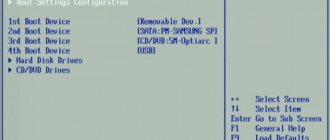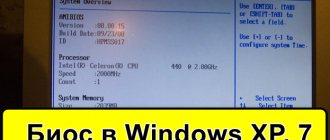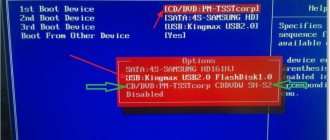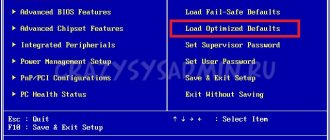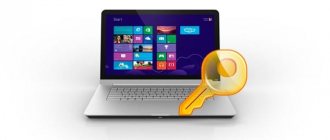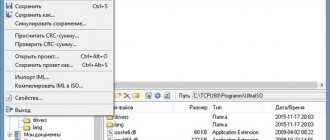What is BIOS
The computer needs to know what to do. How to start the operating system, how to ensure optimal operation of the motherboard, how to set the optimal rotation speed of coolers, and so on. The chip located on the motherboard is responsible for everything. And it is in it that a special program is written - BIOS. All low-level settings of any computer depend on it alone. That's why it's so important, because without the BIOS the laptop simply won't start working.
A stable computer does not cause concern to its owner. But there are situations when it is simply necessary to reconfigure the BIOS. Adjust memory performance, improve processor speed, change system access passwords. Therefore, knowing how to enter the BIOS is far from idle curiosity.
Nothing helps, I can’t enter the BIOS - what should I do?
The first option is that you have a very old laptop with an antediluvian BIOS installed.
In this case, the F10 and Esc buttons will not help you. Therefore, I advise you to try other keys: F 1 Del F 11
The pressing procedure itself is the same, so I will not repeat it. If you have a new laptop, but nothing works, even with old or new buttons, then there is a possibility of a BIOS failure. It happens that you can enter the BIOS, but there is a password there.
What do we do? – in this case, there are only two options: resetting the BIOS or updating it. Next I will describe both options. I recommend reading everything very carefully and not skipping all the steps described.
BIOS update
- Go to the official support website – support.hp.com.
- Select the “Laptop” section.
- Next, you have two options - either use the "Allow HP to identify your product" button. Or you can manually enter the serial number. The serial number is usually indicated on a label that is glued to the bottom of the laptop. In more rare cases, on older models, it was molded under the battery cover.
- As soon as you find your model, open the “BIOS” section and download the latest package.
- After that, we simply install it via Windows. If this does not work for you, then you can update the BIOS from a bootable USB flash drive.
Reset BIOS
If on computers resetting is very simple, then with laptops it is much more difficult, but the scheme itself is similar.
ATTENTION! All of the following instructions should be done only with complete confidence. Before proceeding, be sure to read the instructions completely from start to finish.
- Turn off the laptop and disconnect the power supply.
- We unscrew all the back covers - from the battery (if it is accessible), from the RAM, and the hard drive.
- You need to find the BIOS reset button or pins. We are looking for inscriptions similar to “CLR-CMOS”, “JCMOS”, “CCMOS”. You can find either a separate button or two tiny contacts. If you can’t find something like this, then disconnect the RAM, hard drive and Wi-Fi module. The BIOS reset button or pins should be right on the motherboard.
- If you can’t find the button or jumper, then try to at least find the battery. If you find it, pull it out.
- Once you have found one of the options, you need to connect the power supply. Further:
- We hold down the button and do not release it.
- Take a screwdriver and connect the two contacts to jumpers.
- If you have a battery, then similarly close the two contacts (on the side and bottom of the block) with a screwdriver.
- Now, without opening the contacts (or buttons), turn on your laptop.
- We wait for about 15 seconds and remove the screwdriver (or finger from the button).
- The screen will be completely black - neither the BIOS nor Windows (if there is one) will boot.
- Press and hold the “Power” button until the laptop turns off completely.
- We assemble the laptop and turn it on again.
- Let's try to enter the BIOS.
The process of starting an HP laptop in Windows 8 and 10
To begin with, it is better to seek help from the included instructions for the computer. But happy owners of modern laptops are usually deprived of this opportunity. In the box with the device, other than the power supply and warranty card, most often there is simply no other documentation. And there is also no single standard for entering the initial settings to enter the BIOS on a laptop. Different manufacturers run this process differently. And the owner of the HP Pavilion may need a good reaction in order to quickly find and even quickly press the desired button or key at the first start. At the same time, you must not miss the moment when a hint is visible on the monitor on how to enter the initial settings on the laptop.
But that's not all. Modern laptops use SSDs instead of traditional mechanical HDDs. Performance and speed have improved, so the boot process for Windows 8 and 10 is almost instantaneous. Accordingly, there is no chance of pressing the corresponding button on the keyboard in time.
But the question of how to open access to basic HP settings for Windows 8.1 or 10 can also be solved quite simply:
- Clicking the button Start, find the line “Options».
- In chapter "Update and Security"you need to select the line "Recovery» and activate the Restart Now button.
- We find ourselves in the system closing menu, where a choice of actions is offered. You need to select the section " Diagnostics».
- The window "Extra options" All you have to do is select “ UEFI Firmware Settings».
- We get access directly to the BIOS of the HP laptop.
This method is suitable for one-time login.
But you can make the launch constant every time you boot Windows 8.1 or 10 systems:
- Via button Start find the section "Control Panel».
- By selecting "Power supply", follow the link "What the power buttons do».
- In the window that opens, find the link “Changes to settings that are currently unavailable" Opposite the line " Enable Fast Startup (recommended)» uncheck the box. All that remains is to click the Save changes button.
Now the next time you start the system on HP, it will be much easier to see the BIOS settings.
For HP Pavilion G6 laptops, the BIOS is designed in such a way that even when the system starts, the user can launch the built-in programs that can help in diagnosing or configuring the laptop. It is even possible to reinstall Windows if a bootable system image was created in advance. All operations are activated by special keys, with which you can call, for example, a program for analyzing the RAM and the entire hard drive. You can see all the information about this laptop.
Method 1: Hotkeys
Let's see how you can enter the BIOS on an HP laptop. The problem with all modern laptops is that when they boot up, the start screen is no longer displayed, which means you won't see a hint about hotkeys. Therefore, you need to have time to press the auxiliary key at the moment the primary OS boots. Moreover, the faster and faster your laptop, the less time you have.
So, you need to enable laptop reboot. At the moment of reboot, when the screen goes dark, you need to press the key several times:
Esc
And do this until you see the “Startup Menu”. If this does not work for you, then try the following:
- Turn off your computer.
- Place your finger on the Esc button, but don't do anything yet.
- Click on the "Power" button, which turns on the laptop.
- Immediately at this moment, start pressing the Esc key several times.
- After this, you should be able to open the BIOS start menu.
NOTE! If you still can’t do it, try not pressing Esc, but holding it down and not releasing it until the “Startup Menu” appears.
As soon as this window opens, you just need to click on F10 (BIOS Setup). By the way, if you just need to launch a boot disk or flash drive, you can select “Boot Device Options” (F9).
ADVICE! On newer laptops (younger than 2018), you can directly go to BIOS or EUFI without calling up the auxiliary menu - just use the F10 button. Therefore, if you are unable to enter the BIOS using ESC, you may try the F10 button.
If you still don't succeed, you can try using the Fn auxiliary button. The fact is that some BIOS/UEFI versions specifically disable direct use of all “F” row buttons. Here the procedure is slightly different:
- Reboot the laptop. Or turn it off and on.
- At the very beginning of booting the laptop, when the screen is completely black, but the fans have begun to hum, you need to immediately hold down the Fn button (and not release it), and at the same moment press the Esc (or F10) button several times.
Even if nothing works out here, then don’t worry, let’s see how to enter the BIOS through the installed Windows.
Login procedure for HP Pavilion G6
Let's go into the BIOS on the HP Pavilion G6 step by step:
- Turn off the laptop or reboot.
- Turn it on, and when loading, when the black monitor screen is activated, press and hold the ESC button on the keyboard.
- Enter the start menu, where the built-in program will offer a choice of keys:
- F1 - All information about the HP Pavilion G6 laptop is presented: processor type, amount of RAM, etc.
- F2 - A set of diagnostic programs. You can check the operation of RAM and the condition of the hard drive.
- F9 - It is possible to select the device, DVD drive or flash drive from which the system will be launched.
- F10 - Enter the settings of the BIOS itself.
- F11 - System Restore Tool.
Now all that remains is to press the F10 button on the keyboard. The BIOS of the HP Pavilion G6 laptop will open.
Shell developers specifically give the user the opportunity, even before starting the operating system, to do without special programs.
Where is the BIOS entry key located on older laptops?
Older (before 2013) HP laptop models use different versions of BIOS, so the Basic System Configuration launch buttons may differ. Before loading the device, you can see a message at the bottom of the screen. Most often these are F10 and ESC. Less commonly - Del, F11, F1, F6, F8.
If your laptop was made before 2008, you most likely need to press the Del key.
There are also keyboard combinations Fn + F1, Ctrl + Alt + Delete, Ctrl + Ins, Shift + F10 (for example, HP Pavilion G6, Compaq 6820s, 6910p and others).
There are rare cases when the user is unable to access the interface due to the fact that the laptop is running on battery power. Connect it to a power outlet.
Subtleties
It is also worth noting that on new laptop models, the Esc key opens the start menu, which contains all the tools for setting up the computer, including the BIOS.
Start menu
Start menu on a laptop
The boot menu provides the user with more options for customizing and displaying all aspects of the laptop. Let's look at each of the functions:
- F1 System Information All data about your computer is collected here, namely its technical characteristics. You can also find out the type of motherboard, amount of memory, get information about the hard drive, etc.;
Window called by the "F1 System Information" function - F2 System Diagnostics This section contains standard diagnostic programs for your system components to identify problems, or simply routinely check device resources. Diagnostic tools check the hard drive, RAM and their operation;
Window called by the “F2 System Diagnostics” function - F9 Boot Device Options An option moved from the general BIOS menu on older laptops. This function helps configure the operating system to boot from a specific storage medium. It will help “direct” the computer to the correct port if you need to boot Windows from a flash drive or disk;
Window called by the function “F9 Boot Device Options” - F10 BIOS Setup. Opens the settings directly in the BIOS. It contains information about the system time, basic system characteristics, security settings, additional diagnostic tools and system configuration;
Window called up by the “F10 BIOS Setup” function - F11 System Recovery. Go to the menu for selecting system boot options. Necessary for restoring the operating system after an unexpected shutdown, safe startup, and other types of system startup.
Window called up by the “F11 System Recovery” function
What buttons can be used to enter the BIOS settings of an HP computer?
We present to your attention the most common keyboard combinations, when activated, the user can gain access to the basic control system of a Hewlett-Packard brand computing device.
- For laptops, press “ESC”, then “F10” or “F12”.
- Stationary modifications (Desktop): “Delete”, “F1” or “F2”.
In particularly “exotic cases” you can use one of these combinations:
So, it's time to use the hint. Let us remind you once again that changing critical parameters in the Bios system can cost you a lot!
How to update HP BIOS and install drivers on a laptop
To do this, just go to the official HP website and enter the name of your laptop, and if you don’t know, then the BIOS serial number (Serial Number) - https://support.hp.com/ru-ru/drivers.
A page will open with sections for downloading drivers, for example, for audio, graphics, mouse, keyboard, chipset, and more.
- To update the BIOS, open the BIOS tab and download the utility.
- Install the utility as a regular program. After launch, you will see the “HP System BIOS Update Utility” window. Click the “ Next ” button.
- To create a bootable USB flash drive for updating the BIOS, you must select the “ Create Recovery USB flash drive ” option.
- Before this, you can copy the image of the already installed BIOS version by selecting the “Copy” option.
- Now select the drive and click “ Next ”.
- Click the " Finish " button. The bootable USB flash drive for updating the HP laptop BIOS is ready.
Which key to open the BIOS on your model?
Almost all motherboard and laptop manufacturers program different buttons to open the basic settings menu. Even in different models of the same line of laptops, the key to enter the settings menu may differ.
Tip: If you need to get into the BIOS settings, open the instruction manual for your device. It probably contains a description of how to enter the BIOS of your laptop computer.
If you do not have a paper version of the manual, you can always find it on the official support website in pdf format.
You can do it differently, reboot the device and after self-testing the equipment, carefully look at the screen. It displays a notification for a few seconds (usually at the bottom) about how you can call the desired interface in HP.
When you see it, you need to press the corresponding key on the keyboard.
Rice. 2. Load window
If on most computers the role of this key is played by Del, then for a laptop it is: the F10 (the most popular), Esc, F1, F11 and other functional buttons.
Note that they often perform a different role (turning off Wi-Fi, adjusting the volume), and they must be pressed together with the Fn .
In cases where you do not have time to see where this inscription appears or press the key in time to call up the BIOS on your HP model, try rebooting the laptop several times and each time clicking one of the function buttons (except F8), Delete and Esc. Surely after several reboots you will get to the required menu.
A feature of many HP devices is that you can launch the basic settings window using two buttons pressed sequentially. The most common is Esc, pressed immediately after self-testing.
Afterwards, a menu with boot options will appear on the screen (for example, on HP Pavilion), where we select the desired option using one of the function keys:
- F1 – information about hardware configuration;
- F2 – diagnostic tools built into the system board for testing hardware;
- F9 – select boot device;
- F10 – BIOS settings (by selecting it, we will go to the basic input/output system configurator);
- F11 – system recovery tools;
- Enter – launch Windows.
Updating HP BIOS from Windows
I did it a little differently. I launched the utility and immediately selected the Update BIOS option. At this moment the fan began to work at maximum, so it was a little alarming. Then a warning window appeared, which said that the laptop should be connected to the network, do not turn it off, and do not put it to sleep.
After the update, the laptop reboots and the BIOS update begins.
In this article, we touched on two topics - analysis of entering HP BIOS settings and decoding parameters, as well as updating the BIOS.
HP BIOS Update
We go into the BIOS. At the beginning of the article, we understood how this is done. Now we find on the Main tab information about the system board code ( System Board ID ).
- How to enter Bios on Windows 10?
After writing down the code, you can exit the BIOS.
- Turn on the laptop again and quickly press the ESC key. In the window that appears, go to system diagnostic tools. To do this, press the key F2.
- Make sure your device is connected to charging. Connect the flash drive with the BIOS update files.
- Select the Firmware Management option from the UEFI diagnostic screen .
- In the window that opens, select the “ BIOS Update ” option.
- Next, click on the “ Select BIOS Image To Apply ” option to select the BIOS image.
- Now click on HP_TOOLS, and then HEWLETT_PACKARD.
- Find the image in the BIOSUpdate, CURRENT, PREVIOUS, or NEW folder.
- Now find the file that matches your motherboard code. For example, my motherboard number is 2166, which means the file will be named 02166.bin.
- To install the BIOS update on HP, click the “ Apply Update Now ” button.
On the screen at the time of updating you can see a process that should not be interrupted. Make sure your laptop is connected to the network. If the update fails, the tool will immediately start the recovery process, so there is nothing to worry about.
Operating system tools
The instructions are written using Windows 10 as an example, but for Windows 8 all steps are similar.
1Call the “Options” .
This is done in many ways:
- via Start;
- menu Win + X, called by the keyboard shortcut of the same name;
- using the Win + I button combination.
2In the window, click on the last icon.
Rice. 5. Windows 10 Settings
3Here we go to the “Recovery” and in the subsection with special boot options, select “Restart now” .
Rice. 6. Special download options
The next time you start the system, a system recovery window will appear.
4In it, select the “Diagnostics” item or launch diagnostic tools.
Rice. 7. Select the item “Diagnostics”
5The next step is to call additional parameters.
Rice. 8. Diagnostic tools window
6Here we move the cursor to “Firmware parameters” and perform a left click with the mouse.
Rice. 9. Calling BIOS through the Windows 10 advanced settings window
Afterwards we will be transferred to the menu where the BIOS parameters are changed.
Not all developers make sure that beginners understand how the BIOS starts. On the other hand, novice users will cause less damage to their machines, because having understood the menu items a little, they begin to experiment, for example, with overclocking the processor and looking for information on how to update the BIOS firmware.
How to enter HP BIOS on a laptop
The most proven way is to look at the specifications for your device. Very often, developers indicate how to open the BIOS on a laptop, and HP is no exception. However, documentation is very often lost, so another method should be used.
There are special key combinations that must be pressed at a certain point during computer startup. It is worth noting that even within the same manufacturer, combinations may differ depending on the specific model. To be sure to enter the BIOS, follow these steps:
- Turn on or restart your device.
- During boot, press the key or several keys that are responsible for entering the BIOS on your device. In order not to miss the moment when you need to press a hotkey, try to continuously press the desired key during startup.
- After this, the BIOS will start.
But how do you find out which keys are responsible for starting the BIOS? We have already said that there is no universal recipe. It all depends on the specific model. So let's look at all the possible combinations. If you don’t want to surf the Internet in search of the treasured hotkey, you can find the desired combination using the “poke” method. We will consider all options.
Settings
After entering the Bios settings, the user will see several tabs on the laptop monitor. The first one is where the owner of the laptop will be; it shows the main parameters of laptop modification and settings. These include:
- setting the date and time, here the user can configure these parameters as he pleases;
- laptop model;
- start date of the warranty period;
- processor type and speed;
- RAM memory;
- serial number and some other details from the manufacturer about the laptop.
HP BIOS Settings
In the BIOS settings window, we first see the main menu. The section is called Main.
Main (Menu)
In this section you can see the following parameters:
- System Time – system time;
- System Date – system date;
- Notebook Model – name of the laptop model;
- Product Number – device number;
- System Board ID – system board identifier;
- Born on Date – date of creation;
- Processor Type – processor type;
- Total Memory – amount of RAM;
- BIOS Version – BIOS version;
- BIOS Vendor – BIOS supplier;
- Serial Number – serial number;
- UUID Number – UUID identification number;
- Product configuration ID —product configuration identifier;
- System Board CT Number – serial number of the system board;
- Factory installed OS – installed operating system;
- Primary Battery SN – battery number;
- WLAN FCC ID – network card/Wi-Fi identifier;
- Bluetooth FCC ID – Bluetooth identifier.
The section may also contain information about the language, installed drive and hard drive. These device subsections may contain information about capacity, type, sectors, cylinders, and much more.
Once again, in this article I am mainly describing the parameters of the HP Pavilion 15 laptop, which may not have many options. There is simply an opinion that many settings have been cut out.
Security
There are only two parameters here that are responsible for clearing or setting the administrator password and the power-on password and entering the BIOS.
- How to enter BIOS (UEFI) on Windows 10? All ways
- Administrator Password – Administrator password when entering the BIOS;
- Power-On Password – Password when logging into the system.
System Configuration
This section contains the main parameters, where we set the boot priority, virtualization support, card reader and other parameters.
- Language – setting the language;
- Virtualization technology – enabling virtualization technology that allows you to use the installation of 64-bit systems and virtual machines (Intel Virtualization Technology what is it);
- Card Reader Power Saving – enable or disable the card reader for connecting SD cards to the laptop;
- Fan Always On – the laptop cooler is always on (it is not recommended to disable it);
- Action Keys Mode – disable or enable the FN key on the laptop;
- Boot Option – contains options for enabling UEFI or Legacy BIOS, as well as setting the boot order of devices.
Boot Option
- POST Hotkey Delay (Sec) – delay when loading the POST procedure process;
- CD-ROM Boot – Enable or disable the drive;
- Internal Network Adapter Boot – for devices with no memory storage, where the system boots through a terminal server;
- Network Boot Protocol – enable one or another type of protocol;
- Legacy Support – Enable support for legacy BIOS;
- Secure Boot – Protective boot (Usually does not allow installing unauthorized systems);
- Platform Key – Platform key supplied by the operating system manufacturer;
- Clear All Secure Boot Keys – clear all secure boot keys;
- Load HP Factory Defaults Keys – loads default factory keys.
Exit
The section contains exit options. In most cases they do not differ in
- Exit Saving Changes – exit the BIOS and save the settings;
- Exit Discarding Changes – exit the BIOS without saving settings;
- Load Setup Defaults – reset settings. (Reading: How to reset BIOS settings to factory settings?)

